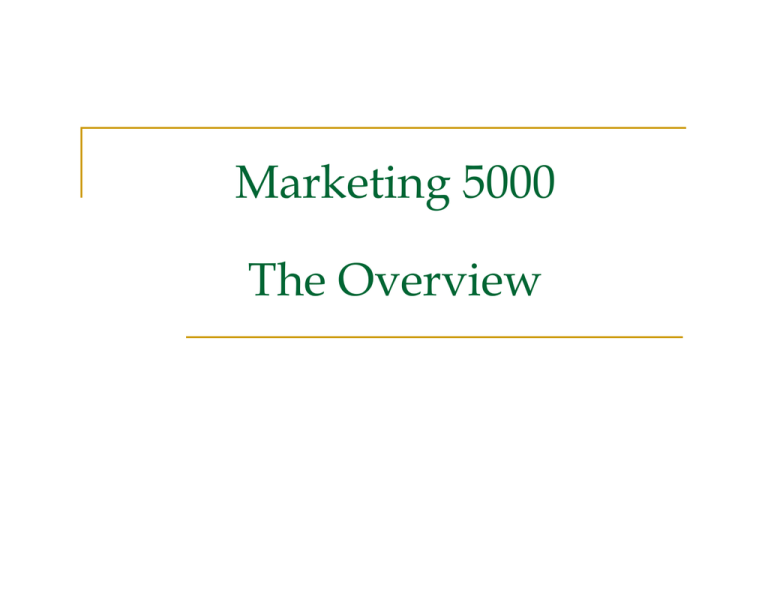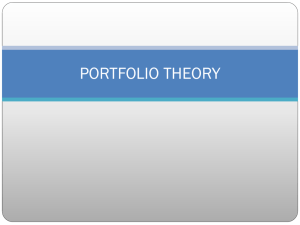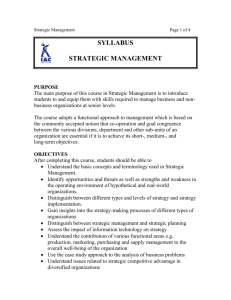Marketing 5000 The Overview
advertisement

Marketing 5000 The Overview Marketing Overview The definition of Marketing used to be: “human activities directed at the satisfaction of needs and wants through exchange processes” (Kotler, Northwestern University) or 2 Marketing Overview “Performance of business activities that direct the flow of goods and services from producer to consumer” (American Marketing Association) or 3 Marketing Overview “the process of identifying customer needs; conceptualizing those needs in terms of an organization’s capacity to produce; communicating the conceptualization to the appropriate laws of power in the organization; conceptualizing the consequent output in terms of the customer needs earlier identified; and communicating that conceptualization to the customer” (Howard, Columbia University) or 4 Marketing Overview “the process of creating, distributing, promoting, and pricing goods, services and ideas to facilitate satisfying exchange relationships with customers in a dynamic environment” (Pride [Texas A&M] - Ferrell, [Colorado State]) 5 Marketing Overview Is this enough? Is knowing what the customer wants enough when all of your competitors know it as well? Or is success based primarily on strategies and tactics? 6 Marketing Overview A better definition of marketing: Marketing is War! 7 Marketing Overview “War belongs to the province of business competition, which is also a conflict of human interests and activities.” (Karl von Clausewitz, On War) 8 Marketing Overview The true nature of marketing today involves the conflict between corporations. Not the satisfying of human needs and wants! 9 Marketing Overview • • • • • • • What is the role of Marketing in a company? Understand the customer, the target market Understand the competition Support the sales function Create shareholder value Determine what products a company can sell Providing customer value What else? 10 Marketing Overview What do we mean when we use the term “Marketing Concept”? A view from the perspective that we will offer to a given target audience what we can profitably sell using a clearly defined set of actions! 11 Marketing Overview Define “Providing value to customers” • • • In terms of the Price/Value ratio In terms of product features In terms of product benefits 12 Marketing Overview What is the “Marketing Mix?” 13 Marketing Overview What is the “Marketing Mix?” Marketing deals with Products, Distribution, Pricing, and Promotion directed at a particular target audience. Together these elements form the Marketing Mix. 14 Marketing Overview What is “relationship marketing?” 15 Marketing Overview What is “relationship marketing?” Establishing a long-term relationship with a buyer that is mutually beneficial. Often the term “CRM” is used to describe this marketing process. 16 Marketing Overview What leads to defeat in both War and Marketing? • • Over-pessimism (Fear of Failure) Over-optimism (Failure to Fear Failure) 17 Marketing Overview Good Marketing professionals need to understand the nature, causes, and cures of marketing failures 18 Marketing Overview Most Common Marketing Errors • • • • • Failure to keep products/services up-to-date Failure to estimate market potential accurately Failure to gauge the trend of the market Failure to appreciate regional differences in market potential and in trend of market Failure to appreciate seasonal differences in your customers’ demand 19 Marketing Overview Most Common Marketing Errors • • • • • Failure to establish the advertising budget based on the job to be done Failure to adhere to policies established in connection with long-range goals Failure to test-market new ideas Failure to differentiate between long-term strategies and short-term tactics Failure to admit defeat 20 Marketing Overview Most Common Marketing Errors • • • • Failure to try new ideas while a brand is climbing Failure to integrate all phases of the marketing operation into the over-all program Failure to appraise objectively your competitors’ brands Failure to get the facts and interpret them correctly 21 Marketing Overview Differences Between Production-Oriented and Market-Oriented Business activity or Production orientation function Product offering Company sells what it can make; primary focus on functional performance and cost. Product line Narrow. Pricing Based on production and distribution costs. Research Technical research; focus on product improvement and cost cutting in the production process. Marketing orientation Company makes what it can sell; primary focus on customers’ needs and market opportunities. Broad. Based on perceived benefits provided. Market research; focus on identifying new opportunities and applying new technology to satisfy customer needs. 22 Marketing Overview Differences Between Production-Oriented and Market-Oriented Business activity or function Packaging Production orientation Marketing orientation Protection for the product; minimize costs. Credit A necessary evil; minimize bad debt losses. Designed for customer convenience; a promotional tool. A customer service; a tool to attract customers. Promotion Emphasis on product Emphasis on product benefits and ability to features, quality, and price. satisfy customers’ needs or solve problems. 23 Strategic Planning Non Sequitur by Wiley Miller 25 Goals and Objectives What’s the difference between a Goal and a Strategy? Goals are commitments. Inflexible, rigid, unwavering, focused. Strategies can be changed, modified or eliminated based on market conditions MRKT 5000 26 Strategy Companies often talk about their strategies. What does strategy mean? A fundamental pattern of present and planned objectives, resource deployments, and interactions of an organization with markets, competitors, and other environmental factors. 27 Components of Strategy Scope Goals and objectives Resource deployments Identification of sustainable competitive advantage Synergy 28 Corporate Growth Strategies New markets Current markets Current products New products Market penetration strategies Product development • Increase market share strategies • • • • Increase product usage Increase frequency of use Increase quantity used New applications Market development strategies • Expand markets for existing products • Geographic expansion • Target new segments • Product improvements • Product-line extensions • New products for same market Diversification strategies • Vertical integration Forward/backward integration • Diversification into related bus (concentric diversification) • Diversification into unrelated businesses (conglomerate diversification) 29 Corporate Growth Strategies Current markets Current products Market penetration strategies • Increase market share • Increase product usage • Increase frequency of use • Increase quantity used • New applications 30 Corporate Growth Strategies Current markets New products Product development strategies • Product improvements • Product-line extensions • New products for same market 31 Corporate Growth Strategies New markets Current products Market development strategies • Expand markets for existing products • Geographic expansion • Target new segments 32 Corporate Growth Strategies New markets New products Diversification strategies • Vertical integration Forward/backward integration • Diversification into related businesses (concentric diversification) • Diversification into unrelated businesses (conglomerate diversification) 33 Contents of a Marketing Plan • • • • • • • • • • Executive summary Current situation (SWOT) and trends Performance review (for an existing good or service only) Key issues Objectives Marketing strategy Action plans Projected profit-and-loss statement Controls Contingency plans 34 Strategic Planning What is a SWOT Analysis? 35 Strategic Planning What is a SWOT Analysis? An assessment of the company’s Strengths, Weaknesses, Opportunities, and Threats. 36 Marketing Jeopardy What are Stars, Cash Cows, Question Marks, and Dogs? The four cells in the Boston Consulting Group growth share matrix 37 Strategic Planning Product Portfolio Matrix Stars Question marks High Market growth rate (in constant dollars) Cash cows Dogs Low High Relative market share Low 38 Decisions Within the Four Elements of the Marketing Mix Product Place • • • • • • Numbers and types of middlemen • Locations/availability • Inventory levels • Transportation Quality • Style Features • Options Brand name • Packaging Guarantees/warranties Services/spare parts The target market Price Promotion • • • • • • • • • • Discounts Allowances Credit terms Payment period Rental/lease List price Advertising Personal selling Sales promotion Point-of-purchase materials • Publicity 39 Key Macro Trends To Evaluate • • • • • • Demographic environment Sociocultural environment Economic environment Political/legal environment Technological environment Physical environment 40 Shifts Occurring in U.S. Demographics • • • • • Family Structure: Traditional is becoming less typical Aging: Baby boomers dominate growth Geographic Distribution: Increase in immigrants and migration of jobs and people to suburbs Ethnic Composition: U.S. becoming more diverse What else? 41 Shifting Values in Western Societies Traditional values New values Self-denial ethic Higher standard of living Traditional sex roles Accepted definition of success Traditional family life Faith in industry, institutions Live to work Hero worship Expansionism Patriotism Unparalleled growth Industrial growth Receptivity to technology Self-fulfillment ethic Better quality of life Blurring of sex roles Individualized definition of success Alternative families Self-reliance Work to live Love of ideas Pluralism Less nationalistic Growing sense of limits Information/service growth Technology orientation 42 Shifting Values in Western Societies Traditional values New values Self-denial ethic Higher standard of living Traditional sex roles Accepted definition of success Traditional family life Faith in industry, institutions Live to work Hero worship Expansionism Patriotism Unparalleled growth Industrial growth Receptivity to technology Self-fulfillment ethic Better quality of life Blurring of sex roles Individualized definition of success Alternative families Self-reliance Work to live Love of ideas Pluralism Less nationalistic Growing sense of limits Information/service growth Technology orientation 43 Economic Environment • • • GDP has increased between rich and poor countries World’s economic growth continues to increase Developing countries are expected to have higher growth rates than developed countries 44 Political/Legal Environment Potential Political Problems • • • • Confiscation Expropriation Domestication Changes in exchange control • • • • Local content laws Import restrictions Taxes Price controls 45 Technological Environment • • • • • • Development of Fiber-optic Cables Storage devices developed to handle the increasing volume of data Use of flexible low-cost wireless transmission Development of low-cost multimedia chip Advances in biology Progress in agriculture 46 Physical Environment • • • • • • Depletion of valuable resources Deserts growing Forests shrinking Lakes dying Quality and quantity of groundwater declining Rise in temperature 47




